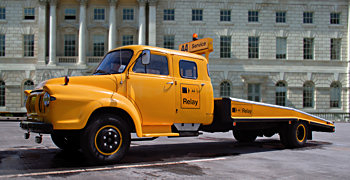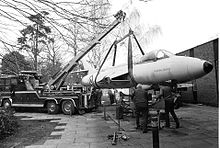User:Andy Lambert/Sandbox
Vehicle Breakdown and Recovery | |
Stuff Happens!Cars have been breaking down ever since they were invented and if a repair was not possible, then a recovery was usually required. To start with, this was often achieved by attaching a horse to the causality and pulling it home. Many of the first garages were bicycle repairers, or blacksmiths and they quickly adapted to recovering their customer’s disabled vehicles. To do this specialised recovery vehicles were often built. As vehicles have become more sophisticated, it has become much harder for the average vehicle owner to diagnose a fault, much less repair it. Motoring Organisations or Clubs have been created to rescue stranded motorist no where more so than in Europe. Car manufactures will often purchase bulk membership to be given away with new car sales. This are often 'badged' with the manufactures name. Because a large number of this Motoring Organisations do not operate recovery vehicles of their own and use independent Recovery Operators as agents. Those that have their own vehicles, also use independent agents to assist with specialist work or when their own resources are stretched. Police forces also use independent recovery operators to move vehicles, for example after a car accident, when vehicles are illegally parked and when required for examination. As the number of recovery operators has grown, a huge industries have been created to serve and support them. Operators have formed their own associations and institutes. A Brief History of the Industry in the UK By the turn of century, some motoring clubs had become large enough to offer a roadside assistance service. In the UK, they were The Automobile Association (formed in 1905) and the Royal Automobile Club (formed in 1897 and named Royal in 1907). The services offered were limited to repairs if possible if not a tow to local garage or the driver’s home if near by (a limit of 20 miles). During the nineteen fifties, both clubs installed radios to allow them to dispatch patrols straight to the incident. Prior to this, the patrols had needed to go to Patrol Box and 'phone in' to see if there were any jobs! In 1969 and 1970 a number of Midland based Recovery Clubs were formed and started to offer a 'get you home service' from anywhere in the UK. The largest of these National Breakdown Recovery Club (today Green Flag) also offered to cover you if you had an accident, something almost unheard of up until then. Unlike the AA and RAC, these new clubs did not operate patrols or have their own recovery vehicles. Instead, they recruited recovery operators, to work as their agents. These agents were selected from the best garages and coachworks. Inspections of the equipment and facilities were regularly carried out, by the clubs own inspectors. Within a few years the AA and then the RAC, responded with their own get you home or relay services. In the years that followed, many other motoring organisations (some from abroad) would join the battle for the motorist membership and this has kept price for membership very low. EquipmentModern Recovery Equipment is extremely sophisticated and manufactured in quantity through out the world. However up until the mid seventies, a large proportion of the equipment in use was home made, often just consisting of a ridged jib and a simple block and tackle. After both world wars, a number of army surplus vehicles were purchased cheaply by garages and converted to civilian use. This was especially true for recovering Trucks and other Commercial Vehicles In 1918 Ernest Holmes of Chattanooga patented the first American commercially successful vehicle recovery crane and its modern decedents have change little in those ninety years. Around the same time recovery cranes were being produced by Weaver Manufacturing and Manley In Europe Harvey Frost Ltd of Great Portland Street London, started selling recovery cranes made by Ernest Lake, from around 1905. The first major change to these crane desings would take another fifty years and came surprisingly from Sweeden. Olaf Ekengard desinged and marketed under the name EKA, a crane that lifted from underneath the casuilty. early all lift and tow vehicles today use veriations of his revelotunery idea. A typical Moden Recovery Fleet will operat a great diversity of diferent types of recovery vehicles. The types of recovery they can acheve, can be divided it to five main areas - Soft TowUsed for very short distance where a rope is attached to the causality, which must have a working breaking system as it will be used to slow both vehicles. Can be dangerous, unless both drivers are competent to do it. Although many people believe this is illegally on motorways it is not in Europe, as long as the relevant trailer laws are complied with i.e. Correctly configured lights and signing, observing trailer speed limits etc.
Bar TowUsed for very short distance where a solid metal bar is attached to the causality. Used mainly with commercial vehicles, which often have a towing eye in the front bumper. In the case of cars and light vans the towing vehicle can be used for breaking, if the bar is kept straight. With commercial vehicles it is common to connect an air feed to the causality to allow the tow vehicle's breaks, to also operate the casualties.
Lift Tow by CraneNow rarely used, but for many years the only way to move a disabled vehicle without using a low loader or trailer. Chains were attached usually around the casualties suspension, some form of packing (often a seat squab or tyre) is inserted between the lifting frame and the casualty. This frame is lifted by means of a pulley until the casualties wheels are clear of the ground. An 'A' frame is normally used to keep the casualty from running into the tow vehicle on breaking Lift Tow by Underlift The image on the right is interesting, in that it show a 'Speclift' that has been modifed to do a standard chain lift as well. This is usfull when the casuilty will not fit into the speclift frame, as in this case. You may also note that the rear is being lifted as it clearly will not tow on a front lift. (click the image to enlarge it) Total Lift or TransportationThe preferred way to travel any distance. Usually the vehicles are purpose built low loading 'Transporters' although trailers are still used especially for the movement of coaches and buses. Some transporter designs are very sophisticated, with bodes that 'demount', to give a low loading angle. This is especially useful for sports cars etc, with low ground clearance. There are also transporters with totally enclosed bodies, used for example for the transportation of prestige vehicle, or vehicle involved in crime that are going for forensic analyses. In the cites it often common to see 'city loaders' a type of transporter fitted with a cradle to totally suspend a vehicle for loading. these are often used to move illegally parked vehicles
Variations of the aboveFor a long while it was common to use 'dollies' to recover vehicles. these were units as in lift by crane and lift by underlift above, but mounted on two wheels. they were designed, to be towed behind a suitable vehicle. Another portable device was a crane, that clipped on to an articulated tractor unit's fifth wheel coupling. Popular in the seventies and eighties, they were cheap to buy (compared with a purpose build recovery vehicle) and appealed to fleet operators, who could use them to recover their own vehicles. Total lift dollies carried by some spectacle lifts, to place under the wheels at the opposite end to the lifted wheels. Thereby converting the tow into a total lift. Used for example when a vehicle has had an accident and both ends are damaged.
Other Equipment 'Righting' overturned vehicle, especially ones that are not badly damaged, has become a science. When a commercial vehicle ends up on its side there will often be little clearance to slid lifting strops underneath it. Even if this can be done the use of strops can cause further damage and are often not the right way to start a lift. To solve this problem recovery operators often use air bags to at least start the lift of the casualty. A number of bags can be used and this spread the load throughout the length of the vehicle. Only a low pressure is used, which means in the event a bag is punctured, it just gently deflates and does not explode. Once the casualty is above 45 degrees a normal winch can be used to finish the job. It is not uncommon to use a second winch from the opposite side, to gently lower the casualty once it has passed the point of balance. It is also quite common for recovery operators to be asked to move other items. The picture right takem in the late eighties, shows a recovery crane lifting an Hunter aircraft before transporting it to Brooklands Musuem in Weybridge England. External linksRecovery Industry Support Charity Association of Vehicle Recovery Operators ReferencesWreck and Recovery by Alan Thomas Published 1987 Patrick Stephens Ltd. Vehicle Recovery By Ron Grice Published 1977 Newnes Butterworths Ltd. We the Professionals I, II, III all by Bill Jackson Published 1983-1989 Wreckers International Ltd. The World History of the Towing and Recovery Industry by John Hawkins published by TT Publications Inc. The Motoring Century (the story of the RAC) by Piers Brendon Published 1997 Bloomsbury Publishing Plc Breakdown Doctor by Fred Henderson Published 2005 by Reading Room Publishing. A History of Recovery Vehicles in the British Army by Brian S Baxtor Published 198 HMSO Wreckers and Tow Trucks by Donald Wood Published 1995 by Motorbooks International |
|

